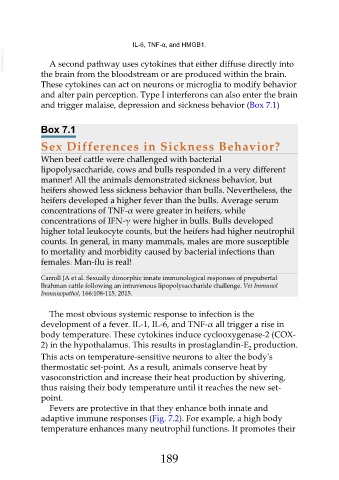Page 189 - Veterinary Immunology, 10th Edition
P. 189
IL-6, TNF-α, and HMGB1.
VetBooks.ir A second pathway uses cytokines that either diffuse directly into
the brain from the bloodstream or are produced within the brain.
These cytokines can act on neurons or microglia to modify behavior
and alter pain perception. Type I interferons can also enter the brain
and trigger malaise, depression and sickness behavior (Box 7.1)
Box 7.1
Sex Differences in Sickness Behavior?
When beef cattle were challenged with bacterial
lipopolysaccharide, cows and bulls responded in a very different
manner! All the animals demonstrated sickness behavior, but
heifers showed less sickness behavior than bulls. Nevertheless, the
heifers developed a higher fever than the bulls. Average serum
concentrations of TNF-α were greater in heifers, while
concentrations of IFN-γ were higher in bulls. Bulls developed
higher total leukocyte counts, but the heifers had higher neutrophil
counts. In general, in many mammals, males are more susceptible
to mortality and morbidity caused by bacterial infections than
females. Man-flu is real!
Carroll JA et al. Sexually dimorphic innate immunological responses of prepubertal
Brahman cattle following an intravenous lipopolysaccharide challenge. Vet Immunol
Immunopathol, 166:108-115, 2015.
The most obvious systemic response to infection is the
development of a fever. IL-1, IL-6, and TNF-α all trigger a rise in
body temperature. These cytokines induce cyclooxygenase-2 (COX-
2) in the hypothalamus. This results in prostaglandin-E production.
2
This acts on temperature-sensitive neurons to alter the body's
thermostatic set-point. As a result, animals conserve heat by
vasoconstriction and increase their heat production by shivering,
thus raising their body temperature until it reaches the new set-
point.
Fevers are protective in that they enhance both innate and
adaptive immune responses (Fig. 7.2). For example, a high body
temperature enhances many neutrophil functions. It promotes their
189

